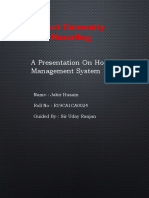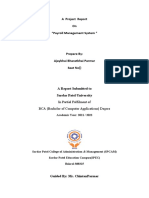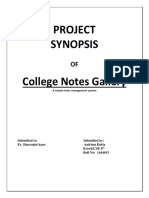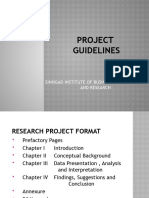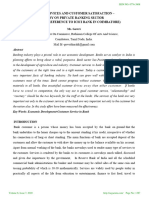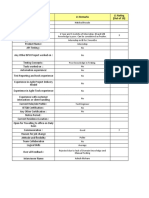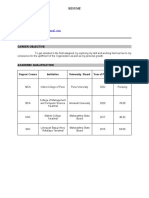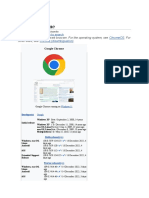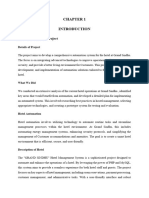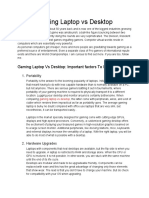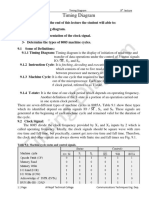Project Report
Project Report
Uploaded by
Ashish MOHARECopyright:
Available Formats
Project Report
Project Report
Uploaded by
Ashish MOHARECopyright
Available Formats
Share this document
Did you find this document useful?
Is this content inappropriate?
Copyright:
Available Formats
Project Report
Project Report
Uploaded by
Ashish MOHARECopyright:
Available Formats
AAKANKSHA UJAWANE RTO MANAGEMENT SYSTEM
CHAPTER 1
INTRODUCTION
CMCS, Yavatmal (2022-23) 1
AAKANKSHA UJAWANE RTO MANAGEMENT SYSTEM
CHAPTER 1
INTRODUCTION
RTO Information System (RTA) is an online information source developed for
Road Transport Authority to facilitate the users in applying for various licenses and
registrations. This tool has been designed to facilitate the flow of information within
the organization. RTO provides the facility of applying licenses online, issuance of
permanent license, tax challans, and receiving payments against challans.
The System keeps track of the transactions in the RTO office. It maintains
Renewal of learner’s License, Renewal of permanent license, Issue of learner’s
license, Online LLR Form, Registration Form, Issue of permanent license, payment
against challan and finally it produces printouts to payment of customers.
RTO Management System- Information System is an online information
source developed for Road Transport Authority to facilitate the users in applying for
various licenses and registrations. This tool has been designed to facilitate the flow of
information within the organization. E-CHALLANS provides the facility of applying
licenses online, issuance of permanent license, tax challans, and receiving payments
against challans.
In the Previous System It is not efficient in performing office work in
RTO services, it includes much manual process and time consuming, It is not user
friendly, Maintains local data base. It is not Generating Accurate Reports.
The Existing system of RTO Management System services has been is usage
for two years. The existing system is not giving accurate results while doing
transactions. It does not provide security; anyone enter into the system and can do
their own transactions. It is not flexible in generating reports and many manual
processes are made computerized.
To overcome problems in the existing System a new RTO services “Road
Transport Authority Information System” is proposed after study of system. The
CMCS, Yavatmal (2022-23) 2
AAKANKSHA UJAWANE RTO MANAGEMENT SYSTEM
objectives of proposed system are: Ensure data integrity and security, less manpower,
Generate accurate reports, Accurate handling in multiple details.
1.1 SYSTEM STUDY
System analysis will be performed to determine if it is feasible to design
information based on policies and plans of the organization and on user requirements
and to eliminate the weaknesses of the present system.
• The new system should be cost effective.
• To augment management, improve productivity and services.
• To enhance user / system interface.
• To improve information, qualify and usability.
• To upgrade systems reliability, availability, flexibility and growth potential.
1. 1. 1 Purpose of the System
The main purpose for preparing this document is to give a general insight into
the analysis and requirements of the existing system or situation and for determining
the operating characteristics of the system.
1. 1. 2 Project Scope
The objective of this application is to develop a system that effectively
manages all the data related to the RTO offices like details of learning licence, details
of driving licence and details of RTO offices. The purpose is to maintain a centralized
database of all RTO office related information. The goal is to support various
functions and processes necessary to manage the data efficiently.
CMCS, Yavatmal (2022-23) 3
AAKANKSHA UJAWANE RTO MANAGEMENT SYSTEM
1. 2 SYSTEM ANALYSIS
1. 2. 1 Existing System
This existing system is not providing secure registration and profile
management of all the users properly. This system is not providing on-line Help. This
system does not provide tracking of user’s activities and their progress. This manual
system gives us very less security for saving data and some data may be lost due to
mismanagement. This system is not providing RTO work management through
internet. This system is not providing proper RTO work information.
1. 2. 2 Proposed System
The development of this new system contains the following activities, which
try to automate the entire process keeping in the view of database integration
approach. This system maintains user’s personal, and contact details. This system will
provide on line help and search capabilities. User friendliness is provided in the
application with various controls provided by system rich user interface.
Authentication is provided for this application only registered users can access.
Licences information files can be stored in centralized database which can be
maintained by the system. This system provides the users, admin and rto offices to
manage the details of RTO data systematically. This system basically lessens the
manual work and improves the quality of maintaining records and other information
related to RTO offices information. One of the solutions that we are going to discuss
here to speed up the database response by using SQL Server database and to reduce
the time complexity by using multi-user environment. Multi-user environment
reduces burden with effortless maintenance.
1.2.3 Project definition
The System keeps track of the transactions in the RTO office. It maintains
Renewal of learner’s License, Renewal of permanent license, Issue of learner’s
license, Online LLR Form, Registration Form, Issue of permanent license, payment
against challans and finally it produces printouts to payment of customers.
CMCS, Yavatmal (2022-23) 4
AAKANKSHA UJAWANE RTO MANAGEMENT SYSTEM
1.2.4. Requirement Specification
The successful running of any project primarily depends upon hardware and
software used in its compilation. The hardware used in the machines should be such
that it supports the software that is to be mounted for assembling the project. This
project deals with hardware and software, which is available readily and easy on each
and every machine given to the user.
Hardware Requirements
• Processor : Intel Pentium-IV or more
• Random Access Memory : 1 GB or more
• Hard Disk : 50 GB
Software Requirements
• Front-End : PHP
• Back End : MY SQL
• Operating System : Windows 8
• XAMPP/WAMPP Server: XAMPP stands for Cross-Platform(X), Apache
(A), MySQL (M), PHP (P) and Perl (P). It is a simple, Lightweight Apache
distribution that makes it extremely easy for developers to create a local web
server for testing purpose. Everything you need to set up a web server-server
application (Apache), database (MySQL) and scripting language (PHP)
CMCS, Yavatmal (2022-23) 5
AAKANKSHA UJAWANE RTO MANAGEMENT SYSTEM
1.2.5 Introduction of Front-end, Back-end and Server
Frontend- PHP
What is PHP?
• PHP is an acronym for "PHP: Hypertext Preprocessor"
• PHP is a widely-used, open-source scripting language
• PHP scripts are executed on the server
• PHP is free to download and use
• PHP is an amazing and popular language!
• It is powerful enough to be at the core of the biggest blogging system on the
web (WordPress)!
• It is deep enough to run the largest social network (Facebook)!
• It is also easy enough to be a beginner's first server-side language!
What is a PHP File?
• PHP files can contain text, HTML, CSS, JavaScript, and PHP code
• PHP code is executed on the server, and the result is returned to the browser as
plain HTML
• PHP files have extension ".php"
What Can PHP Do?
• PHP can generate dynamic page content
• PHP can create, open, read, write, delete, and close files on the server
• PHP can collect form data
• PHP can send and receive cookies
• PHP can add, delete, modify data in your database
• PHP can be used to control user-access
• PHP can encrypt data
With PHP you are not limited to output HTML. You can output images, PDF files,
and even Flash movies. You can also output any text, such as XHTML and XML.
CMCS, Yavatmal (2022-23) 6
AAKANKSHA UJAWANE RTO MANAGEMENT SYSTEM
Why PHP?
• PHP runs on various platforms (Windows, Linux, Unix, Mac OS X, etc.)
• PHP is compatible with almost all servers used today (Apache, IIS, etc.)
• PHP supports a wide range of databases
• PHP is free. Download it from the official PHP resource: www.php.net
• PHP is easy to learn and runs efficiently on the server side
Backend-MySql
MySQL is a fast, easy-to-use RDBMS being used for many small and big
businesses. MySQL is developed, marketed and supported by MySQL AB, which is a
Swedish company. MySQL is becoming so popular because of many good reasons −
• MySQL is released under an open-source license. So you have nothing to pay
to use it.
• MySQL is a very powerful program in its own right. It handles a large subset
of the functionality of the most expensive and powerful database packages.
• MySQL uses a standard form of the well-known SQL data language.
• MySQL works on many operating systems and with many languages including
PHP, PERL, C, C++, JAVA, etc.
• MySQL works very quickly and works well even with large data sets.
• MySQL is very friendly to PHP, the most appreciated language for web
development.
• MySQL supports large databases, up to 50 million rows or more in a table.
The default file size limit for a table is 4GB, but you can increase this (if your
operating system can handle it) to a theoretical limit of 8 million terabytes
(TB).
• MySQL is customizable. The open-source GPL license allows programmers to
modify the MySQL software to fit their own specific environments.
CMCS, Yavatmal (2022-23) 7
AAKANKSHA UJAWANE RTO MANAGEMENT SYSTEM
CHAPTER 2
DESIGN
CMCS, Yavatmal (2022-23) 8
AAKANKSHA UJAWANE RTO MANAGEMENT SYSTEM
CHAPTER 2
DESIGN
SYSTEM DEVELOPMENT LIFE CYCLE
Systems Development Life Cycle (SDLC) is the most common process
adopted to develop a project and not surprisingly, this project is following this model
too. To be precise, waterfall model is being applied. Waterfall model is a sequential
model process where the input of a phase results from the previous phase.
Figure 2. 1: “SDLC Phases”
There are five phases in this model and the first phase is the planning stage.
The planning stage determines the objectives of the project and whether the project
should be given the green light to proceed. This is where the proposal submission
comes into picture. After obtaining the approval, the next phase is analysis.
Gathering and analysing the system and user requirements is essential for entry to the
design step.
With the user requirements gathering completed, there is a need to prepare the
resources for the project. Be it software or hardware components, careful
consideration and selection is to be taken care at this stage. The decision on the
appropriate resources to be used is further elaborated under the subsections below.
The next step is to design the system and database structure.
CMCS, Yavatmal (2022-23) 9
AAKANKSHA UJAWANE RTO MANAGEMENT SYSTEM
Results from the analysis and preparation that were concluded from the
previous stage are put into action. With the user requirements in mind, the flow of the
system is planned and the user interface is designed to suit their easy navigation
needs. In addition, the number of tables, attributes, primary and unique keys of the
database is listed.
After completing the design, actual coding begins. Database is created and
codes are written. Some of the codes required amendments and improvement to it so
these are being developed at this fourth stage of the waterfall model. With the
development completed, testing will begin. The codes and database are tested to
ensure the results obtained are as intended. More time is spent on both development
and testing stages because it is inevitable to have errors and issues and buffer time is
allocated for troubleshooting.
CMCS, Yavatmal (2022-23) 10
AAKANKSHA UJAWANE RTO MANAGEMENT SYSTEM
2.1 Use case Diagram:
2.1.1 Login:
LOGIN
EXISTING USER RTO MANAGEMENT SYSTEM
Fig no 2.1.1: Use Case Diagram of Login
2.1.2 Sign up:
REGISTRATION
NEW USER
SIGN UP LOGIN
Fig no 2.1.2: Use Case Diagram for Sign Up
CMCS, Yavatmal (2022-23) 11
AAKANKSHA UJAWANE RTO MANAGEMENT SYSTEM
2.1.3 User Diagram:
Fig no 2.1.3: User Diagram
CMCS, Yavatmal (2022-23) 12
AAKANKSHA UJAWANE RTO MANAGEMENT SYSTEM
2.1.4 Admin Use Case Diagram:
Fig no 2.1.4: Admin Use Case Diagram
CMCS, Yavatmal (2022-23) 13
AAKANKSHA UJAWANE RTO MANAGEMENT SYSTEM
2.1.5 RTO Use Case Diagram:
Fig no 2.1.5: RTO Use Case Diagram
CMCS, Yavatmal (2022-23) 14
AAKANKSHA UJAWANE RTO MANAGEMENT SYSTEM
2. 2 DFD
The DFD takes an input-process-output view of a system i. e. data objects
flow into the software, are transformed by processing elements, and resultant data
objects flow out of the software.
Data objects represented by labeled arrows and transformation are represented
by circles also called as bubbles. DFD is presented in a hierarchical fashion i. e. the
first data flow model represents the system as a whole. Subsequent DFD refine the
context diagram (level 0 DFD), providing increasing details with each subsequent
level.
The DFD enables the software developer to develop models of the information
domain & functional domain at the same time. As the DFD is refined into greater
levels of details, the analyst performs an implicit functional decomposition of the
system. At the same time, the DFD refinement results in a corresponding refinement
of the data as it moves through the processes that embody the applications.
A context-level DFD for the system the primary external entities produce
information for use by the system and consume information generated by the system.
The labeled arrow represents data objects or object hierarchy.
RULES FOR DFD:
• Fix the scope of the system by means of constant diagrams.
• Organize the DFD so that the main sequence of the actions
• Reads left to right and top to bottom.
• Identify all inputs and outputs.
• Identify and label each process internal to the system with
Rounded circles.
• A process is required for all the data transformation and
Transfers. Therefore, never connect a data store to a data
Source or the destinations or another data store with just a Data
flow arrow.
CMCS, Yavatmal (2022-23) 15
AAKANKSHA UJAWANE RTO MANAGEMENT SYSTEM
• Do not indicate hardware and ignore control information.
• Make sure the names of the processes accurately convey
everything the process is done.
• There must not be unnamed process.
• Indicate external sources and destinations of the data, with
Squares.
• Number each occurrence of repeated external entities.
• Identify all data flows for each process step, except simple
Record retrievals.
• Label data flow on each arrow.
• Use details flow on each arrow.
CMCS, Yavatmal (2022-23) 16
AAKANKSHA UJAWANE RTO MANAGEMENT SYSTEM
2.2.1 Zero Level DFD
Zero Level DFD
Login Admin
Management Management
Authorization RTO Office
Management Management
Changing Enquiry
Password Management
Management RTOMS
Password Learning
Management Licence
Management
Driving Licence State/City
Management Management
Figure 2.2.1 Zero level DFD
CMCS, Yavatmal (2022-23) 17
AAKANKSHA UJAWANE RTO MANAGEMENT SYSTEM
2. 2. 2 First level DFD:
A level 0 DFD, also called a fundamental system model or context diagram
represents the entire software element as a single bubble with input and output data
indicated by incoming and outgoing arrows, respectively.
First Level DFD
Changing
Enquiry Password
Management Management
Admin
Authorization Management
Management
RTO
Login Management
Management
RTOMS
City
Password
Management
Management t
State
LL Management
Management
Generate LL
DL Report
Management
Generate DL
User Report
Management
Figure 2.2.2 First level DFD
CMCS, Yavatmal (2022-23) 18
AAKANKSHA UJAWANE RTO MANAGEMENT SYSTEM
2.2.3 Second Level DFD
Second Level DFD
Check Manage State
Admin Login to
system Roles of
access
Manage City
Manage RTO
Forgot Check
Password Credential Manage
Website Pages
View LL and DL
Licences
Manage
Manage
Module
Enquiry
s
Search LL and
DL Licences
Change Update Profile Generate
View Reg
Password Report
Users
CMCS, Yavatmal (2022-23) 19
AAKANKSHA UJAWANE RTO MANAGEMENT SYSTEM
Second Level DFD
Login to Check
RTO
system Roles of
access
Manage LL
Forgot Check Application
Passwor Credenti
d al
Manage DL
Application
Manage
Generate LL
Module
and DL
s
Reports
Search LL
Licences
Change Update Profile Search DL
Password Licences
CMCS, Yavatmal (2022-23) 20
AAKANKSHA UJAWANE RTO MANAGEMENT SYSTEM
Check
Registered User Signup/
Roles of
sign in access
View About
Us page
Forgot Check View Contact
Password Credential Us page
Sent Enquiry
Manage
Modules
Request
Learning
Licence
View Application Request Learning
Change Password Update Profile
Request Licence
Figure 2.2.3 Second level DFD
CMCS, Yavatmal (2022-23) 21
AAKANKSHA UJAWANE RTO MANAGEMENT SYSTEM
2. 3 ER-Diagram:
The Entity-Relationship (ER) model was originally proposed by Peter in 1976
as a way to unify the network and relational database views. Simply stated the ER
model is a conceptual data model that views the real world as entities and
relationships. A basic component of the model is the Entity-Relationship diagram
which is used to visually represent data objects. Since Chen wrote his paper the
model has been extended and today it is commonly used for database design For the
database designer, the utility of the ER model is:
• It maps well to the relational model. The constructs used in the ER model can
easily be transformed into relational tables.
• It is simple and easy to understand with a minimum of training. Therefore, the
model can be used by the database designer to communicate the design to the end
user.
• In addition, the model can be used as a design plan by the database developer
to implement a data model in specific database management software.
Connectivity and Cardinality
The basic types of connectivity for relations are: one-to-one, one-to-many, and
many-to-many. A one-to-one (1:1) relationship is when at most one instance of a
entity A is associated with one instance of entity B. For example, employees in the
company are each assigned their own office. For each employee there exists a unique
office and for each office there exists a unique employee.
A one-to-many (1: N) relationships is when for one instance of entity A, there
are zero, one, or many instances of entity B, but for one instance of entity B, there is
only one instance of entity A. An example of a 1: N relationships is a department
has many employees each employee is assigned to one department.
CMCS, Yavatmal (2022-23) 22
AAKANKSHA UJAWANE RTO MANAGEMENT SYSTEM
E-R Notation:
There is no standard for representing data objects in ER diagrams. Each
modeling methodology uses its own notation. The original notation used by Chen is
widely used in academics texts and journals but rarely seen in either CASE tools or
publications by non-academics. Today, there are a number of notations used, among
the more common are Bachman, crow's foot, and IDEFIX.
All notational styles represent entities as rectangular boxes and relationships
as lines connecting boxes. Each style uses a special set of symbols to represent the
cardinality of a connection.
The notation used in this document is from Martin. The symbols used for the
basic ER constructs are:
▪ Entities are represented by labeled rectangles. The label is the name of the
entity. Entity names should be singular nouns.
▪ Relationships are represented by a solid line connecting two entities. The name
of the relationship is written above the line. Relationship names should be verbs
▪ Attributes, when included, are listed inside the entity rectangle. Attributes
which are identifiers are underlined. Attribute names should be singular nouns.
▪ Cardinality of many is represented by a line ending in a crow's foot. If the
crow's foot is omitted, the cardinality is one.
CMCS, Yavatmal (2022-23) 23
AAKANKSHA UJAWANE RTO MANAGEMENT SYSTEM
2.3.1 E-R-Diagram
Figure 2.3.1 ER Diagram
CMCS, Yavatmal (2022-23) 24
AAKANKSHA UJAWANE RTO MANAGEMENT SYSTEM
2. 4 DATABASE DESIGN
2. 4. 1 Admin Table
Table: 2. 4. 1 Admin Table
2. 4. 2 Table City
2. 4. 2 Table City
2. 4. 3 Table Contact
2. 4. 3 Table Contact
CMCS, Yavatmal (2022-23) 25
AAKANKSHA UJAWANE RTO MANAGEMENT SYSTEM
2. 4. 4 Table Driving License
2. 4. 4 Table Driving License
2.4.5 Learning License Table
2.4.5 Learning License Table
CMCS, Yavatmal (2022-23) 26
AAKANKSHA UJAWANE RTO MANAGEMENT SYSTEM
2.4.6 Table Page
2.4.6 Table Page
2.4.7 Table RTO
2.4.7 Table RTO
CMCS, Yavatmal (2022-23) 27
AAKANKSHA UJAWANE RTO MANAGEMENT SYSTEM
2.4.8 Table State
2.4.8 Table State
2.4.9 Table User
2.4.9 Table User
CMCS, Yavatmal (2022-23) 28
AAKANKSHA UJAWANE RTO MANAGEMENT SYSTEM
2.5 Module Description
RTO Management System Module
In RTOMS project we use PHP and MySQL database. It has three modules.
1.Admin Module
2.User Module
3.RTO Office
Admin Module
1. Dashboard: In this section, admin can see all detail in brief like the total
registered users, Total Learning License Application, Total Driving License
Application, Total State, Total City, Total Read Enquiry and Total Unread
Enquiry.
2. State: In this section, admin can manage state(add/delete/update).
3. City: In this section, admin can manage city(add/delete/update).
4. RTO: In this section, admin can manage rto(add/delete/update).
5. Pages: In This section, admin can manage websites pages.
6. License Application:
a. Learning License: In this section, admin can view the learning license
application which is sent by registered users.
b. Driving License: In this section, admin can view the driving license
application which is sent by registered users.
7. Enquiry: In this section, admin can view and maintain the enquiry.
8. Report: In this section, admin between dates report of learning license and
driving license.
9. Search:
CMCS, Yavatmal (2022-23) 29
AAKANKSHA UJAWANE RTO MANAGEMENT SYSTEM
a. Search Learning License: In this section, admin can search learning
license application by help of application number and by name.
b. Search Driving License: In this section, admin can search driving license
application by help of application number and by name.
10. View Reg Users: In this section, admin view the detail of registered users.
Admin can also update his profile, change password, and recover password.
User Module
1. Dashboard: This is welcome page of user.
2. Apply For New Licence: In this section, user can send learning or driving
licence request.
3. My Accounts: In this section, user can view and update the his/her profile and
password.
4. Request History: In this section, user can check the status of applied
application.
5. About Us: In this section, user can view the details of website.
6. Contact Us: In this section, user can send the enquiry.
User can also update his profile, change password, and recover password.
RTO Office
1. Dashboard: In this section, RTO officer can see all detail in brief like Total
New Learning License Application, Total Accepted Learning License
Application, Total Rejected Learning License Application, Total New Driving
License Application, Total Accepted Driving License Application, Total
Rejected Driving License Application.
CMCS, Yavatmal (2022-23) 30
AAKANKSHA UJAWANE RTO MANAGEMENT SYSTEM
2. Learning License Request: In this section, RTO officer can manage Learning
License request which is sent by registered users.
3. Driving License Request: In this section, RTO officer can manage Driving
License request which is sent by registered users.
4. Report: In this section, RTO officer between dates report of learning license
and driving license.
5. Search:
a. Search Learning License: In this section, admin can search learning license
application by help of application number and by name.
b. Search Driving license: In this section, admin can search driving license
application by help of application number and by name.
RTO officer can view rto details, change password and recover password.
CMCS, Yavatmal (2022-23) 31
AAKANKSHA UJAWANE RTO MANAGEMENT SYSTEM
2.6 OUTPUT FORMS
Home Page
This is Home Page.
CMCS, Yavatmal (2022-23) 32
AAKANKSHA UJAWANE RTO MANAGEMENT SYSTEM
About Us Page
This is About us page.
CMCS, Yavatmal (2022-23) 33
AAKANKSHA UJAWANE RTO MANAGEMENT SYSTEM
Contact Us Page
This is contact us page.
CMCS, Yavatmal (2022-23) 34
AAKANKSHA UJAWANE RTO MANAGEMENT SYSTEM
Signup Page
This page allows users to register their account.
CMCS, Yavatmal (2022-23) 35
AAKANKSHA UJAWANE RTO MANAGEMENT SYSTEM
Login Page
This page allows the existing users to login.
CMCS, Yavatmal (2022-23) 36
AAKANKSHA UJAWANE RTO MANAGEMENT SYSTEM
Forget Password Page
This page allows the users to recover their password.
CMCS, Yavatmal (2022-23) 37
AAKANKSHA UJAWANE RTO MANAGEMENT SYSTEM
User Profile Page
This is user profile page.
CMCS, Yavatmal (2022-23) 38
AAKANKSHA UJAWANE RTO MANAGEMENT SYSTEM
Change Password Page
This allows users to change their password.
CMCS, Yavatmal (2022-23) 39
AAKANKSHA UJAWANE RTO MANAGEMENT SYSTEM
Learning License Form
Users can request for the learning license using this form.
CMCS, Yavatmal (2022-23) 40
AAKANKSHA UJAWANE RTO MANAGEMENT SYSTEM
History of Learning License
This page shows the history of applications applied by the user.
CMCS, Yavatmal (2022-23) 41
AAKANKSHA UJAWANE RTO MANAGEMENT SYSTEM
View Details of Learning License
This page shows the details of learning license.
CMCS, Yavatmal (2022-23) 42
AAKANKSHA UJAWANE RTO MANAGEMENT SYSTEM
Driving Licence Form
This page allows users to fill the application form for the Permanent Driving License.
CMCS, Yavatmal (2022-23) 43
AAKANKSHA UJAWANE RTO MANAGEMENT SYSTEM
History of Driving Licence
This page shows the history of permanent driving license.
CMCS, Yavatmal (2022-23) 44
AAKANKSHA UJAWANE RTO MANAGEMENT SYSTEM
View History of Driving Licence
This page shows the status of driving license application.
CMCS, Yavatmal (2022-23) 45
AAKANKSHA UJAWANE RTO MANAGEMENT SYSTEM
RTO Officer Panel
Login Page
Forgot Password
Reset Password
CMCS, Yavatmal (2022-23) 46
AAKANKSHA UJAWANE RTO MANAGEMENT SYSTEM
Dashboard
Profile
Change Password
CMCS, Yavatmal (2022-23) 47
AAKANKSHA UJAWANE RTO MANAGEMENT SYSTEM
New Learning Licence Request
View New Learning Licence Request
CMCS, Yavatmal (2022-23) 48
AAKANKSHA UJAWANE RTO MANAGEMENT SYSTEM
Accepted Learning Request
View Accepted Learning Request
CMCS, Yavatmal (2022-23) 49
AAKANKSHA UJAWANE RTO MANAGEMENT SYSTEM
Rejected Learning Request
View Rejected Learning Licence
CMCS, Yavatmal (2022-23) 50
AAKANKSHA UJAWANE RTO MANAGEMENT SYSTEM
New Driving Licence Request
View New Driving Licence Request
CMCS, Yavatmal (2022-23) 51
AAKANKSHA UJAWANE RTO MANAGEMENT SYSTEM
Accepted Driving Licence
View Accepted Driving Licence
CMCS, Yavatmal (2022-23) 52
AAKANKSHA UJAWANE RTO MANAGEMENT SYSTEM
Between Dates Report of Learning Licence
View Between Dates Report of Learning Licence
CMCS, Yavatmal (2022-23) 53
AAKANKSHA UJAWANE RTO MANAGEMENT SYSTEM
Between Dates Report of Driving Licence
View Between Dates Report of Driving Licence
Search Learning Licence
CMCS, Yavatmal (2022-23) 54
AAKANKSHA UJAWANE RTO MANAGEMENT SYSTEM
View Search Learning Licence
Search Driving Licence
View Search Driving Licence
CMCS, Yavatmal (2022-23) 55
AAKANKSHA UJAWANE RTO MANAGEMENT SYSTEM
Admin Panel
Forgot Password
Reset Password
CMCS, Yavatmal (2022-23) 56
AAKANKSHA UJAWANE RTO MANAGEMENT SYSTEM
Dashboard
Profile
CMCS, Yavatmal (2022-23) 57
AAKANKSHA UJAWANE RTO MANAGEMENT SYSTEM
Change Password
Add State
CMCS, Yavatmal (2022-23) 58
AAKANKSHA UJAWANE RTO MANAGEMENT SYSTEM
Manage State
Update State
CMCS, Yavatmal (2022-23) 59
AAKANKSHA UJAWANE RTO MANAGEMENT SYSTEM
Add City
Manage City
CMCS, Yavatmal (2022-23) 60
AAKANKSHA UJAWANE RTO MANAGEMENT SYSTEM
Update City
Add RTO
CMCS, Yavatmal (2022-23) 61
AAKANKSHA UJAWANE RTO MANAGEMENT SYSTEM
Manage RTO
Update RTO
CMCS, Yavatmal (2022-23) 62
AAKANKSHA UJAWANE RTO MANAGEMENT SYSTEM
About Us Page
Contact Us Page
CMCS, Yavatmal (2022-23) 63
AAKANKSHA UJAWANE RTO MANAGEMENT SYSTEM
All Learning Application
View Details of Learning Licence
CMCS, Yavatmal (2022-23) 64
AAKANKSHA UJAWANE RTO MANAGEMENT SYSTEM
All Driving Licence
View Driving Licence
CMCS, Yavatmal (2022-23) 65
AAKANKSHA UJAWANE RTO MANAGEMENT SYSTEM
Between Dates report of Learning Licence
View Between Dates report of Learning Licence
CMCS, Yavatmal (2022-23) 66
AAKANKSHA UJAWANE RTO MANAGEMENT SYSTEM
Between Dates report of Driving Licence
View Between Dates report of Driving Licence
CMCS, Yavatmal (2022-23) 67
AAKANKSHA UJAWANE RTO MANAGEMENT SYSTEM
Search Learning Licence Application
Search Driving Licence
CMCS, Yavatmal (2022-23) 68
AAKANKSHA UJAWANE RTO MANAGEMENT SYSTEM
User Details
View User wise learning and driving request
CMCS, Yavatmal (2022-23) 69
AAKANKSHA UJAWANE RTO MANAGEMENT SYSTEM
CHAPTER 3
IMPLEMENTATION
CMCS, Yavatmal (2022-23) 70
AAKANKSHA UJAWANE RTO MANAGEMENT SYSTEM
CHAPTER 3
IMPLEMENTATION
Index Page
<?php
session_start();
error_reporting(0);
include('includes/config.php');
?>
<!DOCTYPE html>
<html>
<head>
<title>RTO Management System || Home Page</title>
<script type="application/x-javascript"> addEventListener("load", function() {
setTimeout(hideURLbar, 0); }, false);
function hideURLbar(){ window.scrollTo(0,1); } </script>
<!-- //for-mobile-apps -->
<link href="css/bootstrap.css" rel="stylesheet" type="text/css" media="all" />
<link href="css/style.css" rel="stylesheet" type="text/css" media="all" />
<!-- js -->
<script type="text/javascript" src="js/jquery-2.1.4.min.js"></script>
<!-- //js -->
<!-- load-more -->
<script>
$(document).ready(function () {
size_li = $("#myList li").size();
CMCS, Yavatmal (2022-23) 71
AAKANKSHA UJAWANE RTO MANAGEMENT SYSTEM
x=1;
$('#myList li:lt('+x+')').show();
$('#loadMore').click(function () {
x= (x+1 <= size_li) ? x+1 : size_li;
$('#myList li:lt('+x+')').show();
});
$('#showLess').click(function () {
x=(x-1<0) ? 1 : x-1;
$('#myList li').not(':lt('+x+')').hide();
});
});
</script>
<!-- //load-more -->
<link
href='//fonts.googleapis.com/css?family=Lato:400,100,100italic,300,300italic,400itali
c,700,700italic,900,900italic' rel='stylesheet' type='text/css'>
<link
href='//fonts.googleapis.com/css?family=Open+Sans:400,300,300italic,400italic,600,
600italic,700,700italic,800,800italic' rel='stylesheet' type='text/css'>
</head>
<body>
<!-- header -->
<?php include_once('includes/header.php');?>
<!-- //header -->
<!-- banner -->
<div class="banner">
CMCS, Yavatmal (2022-23) 72
AAKANKSHA UJAWANE RTO MANAGEMENT SYSTEM
<div class="container">
<div class="w3ls_banner_info">
<h2>RTO MANAGEMENT SYSTEM</h2>
<p>Road Transport Office Management System</p>
</div>
</div>
</div>
<!-- //banner -->
<!-- footer -->
<?php include_once('includes/footer.php');?>
<!-- //footer -->
<!-- for bootstrap working -->
<script src="js/bootstrap.js"></script>
<!-- //for bootstrap working -->
</body>
</html>
About us
<?php
CMCS, Yavatmal (2022-23) 73
AAKANKSHA UJAWANE RTO MANAGEMENT SYSTEM
session_start();
error_reporting(0);
include('includes/config.php');
?>
<!DOCTYPE html>
<html>
<head>
<title>RTO Management System | About Us</title>
<script type="application/x-javascript"> addEventListener("load", function() {
setTimeout(hideURLbar, 0); }, false);
function hideURLbar(){ window.scrollTo(0,1); } </script>
<!-- //for-mobile-apps -->
<link href="css/bootstrap.css" rel="stylesheet" type="text/css" media="all" />
<link href="css/style.css" rel="stylesheet" type="text/css" media="all" />
<!-- js -->
<script type="text/javascript" src="js/jquery-2.1.4.min.js"></script>
<!-- Stats-Number-Scroller-Animation-JavaScript -->
<script src="js/waypoints.min.js"></script>
<script src="js/counterup.min.js"></script>
<script>
jQuery(document).ready(function( $ ) {
$('.counter').counterUp({
delay: 10,
time: 1000
});
});
</script>
CMCS, Yavatmal (2022-23) 74
AAKANKSHA UJAWANE RTO MANAGEMENT SYSTEM
<!-- //Stats-Number-Scroller-Animation-JavaScript -->
<!-- //js -->
<link
href='//fonts.googleapis.com/css?family=Lato:400,100,100italic,300,300italic,400itali
c,700,700italic,900,900italic' rel='stylesheet' type='text/css'>
<link
href='//fonts.googleapis.com/css?family=Open+Sans:400,300,300italic,400italic,600,
600italic,700,700italic,800,800italic' rel='stylesheet' type='text/css'>
</head>
<body>
<!-- header -->
<?php include_once('includes/header.php');?>
<!-- //header -->
<!-- banner1 -->
<div class="banner1">
<div class="container">
</div>
</div>
<div class="services-breadcrumb">
<div class="container">
<ul>
<li><a href="index.php">Home</a><i>|</i></li>
<li>About Us</li>
</ul>
</div>
</div>
<!-- //banner1 -->
<!-- about -->
CMCS, Yavatmal (2022-23) 75
AAKANKSHA UJAWANE RTO MANAGEMENT SYSTEM
<div class="about">
<div class="container">
<h3>About Us</h3>
<p class="quia">detail description about RTO MS</p>
<div class="agile_about_grids">
<div class="col-md-6 agile_about_grid_left">
<div class="col-md-6 agile_about_grid_left1">
<img src="images/6.jpg" alt=" "
class="img-responsive" />
</div>
<div class="col-md-6 agile_about_grid_left1">
<img src="images/7.jpg" alt=" "
class="img-responsive" />
</div>
<div class="clearfix"> </div>
<img class="agile_about_grid_left_img img-
responsive" src="images/banner.jpg" alt=" " />
</div>
<div class="col-md-6 agile_about_grid_right">
<?php
$ret=mysqli_query($con,"select * from tblpage where PageType='aboutus' ");
$cnt=1;
while ($row=mysqli_fetch_array($ret)) {
?>
<h4><?php echo $row['PageTitle'];?></h4>
<p><?php echo
$row['PageDescription'];?></p><?php } ?>
CMCS, Yavatmal (2022-23) 76
AAKANKSHA UJAWANE RTO MANAGEMENT SYSTEM
</div>
<div class="clearfix"> </div>
</div>
</div>
</div>
<!-- //about -->
<!-- footer -->
<?php include_once('includes/footer.php');?>
<!-- //footer -->
<!-- for bootstrap working -->
<script src="js/bootstrap.js"></script>
<!-- //for bootstrap working -->
</body>
</html>
All DL Request
<?php
session_start();
error_reporting(0);
include('includes/config.php');
if (strlen($_SESSION['rtomsuid']==0)) {
header('location:logout.php');
} else{
?>
CMCS, Yavatmal (2022-23) 77
AAKANKSHA UJAWANE RTO MANAGEMENT SYSTEM
<!DOCTYPE html>
<html>
<head>
<title>RTO Management System || All Driving Licence Request</title>
<script type="application/x-javascript"> addEventListener("load", function() {
setTimeout(hideURLbar, 0); }, false);
function hideURLbar(){ window.scrollTo(0,1); } </script>
<!-- //for-mobile-apps -->
<link href="css/bootstrap.css" rel="stylesheet" type="text/css" media="all" />
<link href="css/style.css" rel="stylesheet" type="text/css" media="all" />
<!-- js -->
<script type="text/javascript" src="js/jquery-2.1.4.min.js"></script>
<!-- //js -->
<link
href='//fonts.googleapis.com/css?family=Lato:400,100,100italic,300,300italic,400itali
c,700,700italic,900,900italic' rel='stylesheet' type='text/css'>
<link
href='//fonts.googleapis.com/css?family=Open+Sans:400,300,300italic,400italic,600,
600italic,700,700italic,800,800italic' rel='stylesheet' type='text/css'>
<script>
function getcity(val1) {
$.ajax({
type:"POST",
url:"get_city.php",
data:'$stateid='+val1,
success:function(data){
$("#city").html(data);
CMCS, Yavatmal (2022-23) 78
AAKANKSHA UJAWANE RTO MANAGEMENT SYSTEM
});
</script>
</head>
<body>
<!-- header -->
<?php include_once('includes/header.php');?>
<!-- //header -->
<!-- banner1 -->
<div class="banner1">
<div class="container">
</div>
</div>
<div class="services-breadcrumb">
<div class="container">
<ul>
<li><a href="index.php">Home</a><i>|</i></li>
<li>All Driving Licence Request</li>
</ul>
</div>
</div>
<!-- //banner1 -->
<!-- mail -->
<div class="mail">
<div class="container">
CMCS, Yavatmal (2022-23) 79
AAKANKSHA UJAWANE RTO MANAGEMENT SYSTEM
<h3>All Driving Licence Request</h3>
<p class="quia">Check Your Driving Licence Request</p>
<div class="col-md-12 wthree_contact_left">
<h4>Driving Licence Request Status</h4>
<table class="table table-bordered">
<thead>
<tr>
<th>#</th>
<th>Application Number</th>
<th>RTO Name</th>
<th>Name</th>
<th>Mobile Number</th>
<th>Email</th>
<th>Apply Date</th>
<th>Status</th>
<th>Action</th>
</tr>
</thead>
<tbody>
<?php
$uid=$_SESSION['rtomsuid'];
$ret=mysqli_query($con,"select tblrto.ID as rtoid,tblrto.NameofRTO,tblrto.StateID as
rstid,tblrto.CityID as rctid,tblldicence.ID as
dlid,tblldicence.ApplicationNumber,tblldicence.StateID as dlsid,tblldicence.CityID as
dlcid,tblldicence.ApplyDate,tblldicence.Status,users.id,users.FirstName,users.LastNa
me,users.MobileNumber,users.Email from tblldicence
CMCS, Yavatmal (2022-23) 80
AAKANKSHA UJAWANE RTO MANAGEMENT SYSTEM
join users on users.id=tblldicence.UserId
left join tblrto on tblrto.CityID=tblldicence.CityID where
tblldicence.UserId=$uid");
$cnt=1;
while ($row=mysqli_fetch_array($ret)) {
?>
<tr>
<td><?php echo $cnt;?></td>
<td><?php echo $row['ApplicationNumber'];?></td>
<td><?php echo $row['NameofRTO'];?></td>
<td><?php echo $row['FirstName'];?> <?php echo
$row['LastName'];?></td>
<td><?php echo $row['MobileNumber'];?></td>
<td><?php echo $row['Email'];?></td>
<td><?php echo $row['ApplyDate'];?></td>
<?php if($row['Status']==""){ ?>
<td class="font-w600"><?php echo "Not Updated Yet"; ?></td>
<?php } else { ?>
<td><?php echo $row['Status'];?></td><?php } ?>
<td><a href="view-dl-request.php?appid=<?php echo
$row['ApplicationNumber'];?>" class="btn btn-primary">View Details</a></td>
</tr>
<?php $cnt=$cnt+1; } ?>
</tbody>
</table>
</div>
CMCS, Yavatmal (2022-23) 81
AAKANKSHA UJAWANE RTO MANAGEMENT SYSTEM
<div class="clearfix"> </div>
</div>
</div>
<!-- //mail -->
<!-- footer -->
<?php include_once('includes/footer.php');?>
<!-- //footer -->
<!-- for bootstrap working -->
<script src="js/bootstrap.js"></script>
<!-- //for bootstrap working -->
</body>
</html>
<?php } ?>
All LL Request
<?php
session_start();
error_reporting(0);
include('includes/config.php');
if (strlen($_SESSION['rtomsuid']==0)) {
header('location:logout.php');
} else{
?>
<!DOCTYPE html>
<html>
CMCS, Yavatmal (2022-23) 82
AAKANKSHA UJAWANE RTO MANAGEMENT SYSTEM
<head>
<title>RTO Management System || All Learing Licence Request</title>
<script type="application/x-javascript"> addEventListener("load", function() {
setTimeout(hideURLbar, 0); }, false);
function hideURLbar(){ window.scrollTo(0,1); } </script>
<!-- //for-mobile-apps -->
<link href="css/bootstrap.css" rel="stylesheet" type="text/css" media="all" />
<link href="css/style.css" rel="stylesheet" type="text/css" media="all" />
<!-- js -->
<script type="text/javascript" src="js/jquery-2.1.4.min.js"></script>
<!-- //js -->
<link
href='//fonts.googleapis.com/css?family=Lato:400,100,100italic,300,300italic,400itali
c,700,700italic,900,900italic' rel='stylesheet' type='text/css'>
<link
href='//fonts.googleapis.com/css?family=Open+Sans:400,300,300italic,400italic,600,
600italic,700,700italic,800,800italic' rel='stylesheet' type='text/css'>
<script>
function getcity(val1) {
$.ajax({
type:"POST",
url:"get_city.php",
data:'$stateid='+val1,
success:function(data){
$("#city").html(data);
});
CMCS, Yavatmal (2022-23) 83
AAKANKSHA UJAWANE RTO MANAGEMENT SYSTEM
</script>
</head>
<body>
<!-- header -->
<?php include_once('includes/header.php');?>
<!-- //header -->
<!-- banner1 -->
<div class="banner1">
<div class="container">
</div>
</div>
<div class="services-breadcrumb">
<div class="container">
<ul>
<li><a href="index.php">Home</a><i>|</i></li>
<li>All Learing Licence Request</li>
</ul>
</div>
</div>
<!-- //banner1 -->
<!-- mail -->
<div class="mail">
<div class="container">
CMCS, Yavatmal (2022-23) 84
AAKANKSHA UJAWANE RTO MANAGEMENT SYSTEM
<h3>All Learing Licence Request</h3>
<p class="quia">Check Your Learing Licence Request</p>
<div class="col-md-12 wthree_contact_left">
<h4>Learing Licence Request Status</h4>
<table class="table table-bordered">
<thead>
<tr>
<th>#</th>
<th>Application Number</th>
<th>RTO Name</th>
<th>Name</th>
<th>Mobile Number</th>
<th>Email</th>
<th>Apply Date</th>
<th>Status</th>
<th>Action</th>
</tr>
</thead>
<tbody>
<?php
$uid=$_SESSION['rtomsuid'];
$ret=mysqli_query($con,"select tblrto.ID as rtoid,tblrto.NameofRTO,tblrto.StateID as
rstid,tblrto.CityID as rctid,tblllicence.ID as
dlid,tblllicence.ApplicationNumber,tblllicence.StateID as dlsid,tblllicence.CityID as
dlcid,tblllicence.ApplyDate,tblllicence.Status,users.id,users.FirstName,users.LastNam
e,users.MobileNumber,users.Email from tblllicence join users on
CMCS, Yavatmal (2022-23) 85
AAKANKSHA UJAWANE RTO MANAGEMENT SYSTEM
users.id=tblllicence.UserId left join tblrto on tblrto.CityID=tblllicence.CityID where
tblllicence.UserId=$uid");
$cnt=1;
while ($row=mysqli_fetch_array($ret)) {
?>
<tr>
<td><?php echo $cnt;?></td>
<td><?php echo $row['ApplicationNumber'];?></td>
<td><?php echo $row['NameofRTO'];?></td>
<td><?php echo $row['FirstName'];?> <?php echo
$row['LastName'];?></td>
<td><?php echo $row['MobileNumber'];?></td>
<td><?php echo $row['Email'];?></td>
<td><?php echo $row['ApplyDate'];?></td>
<?php if($row['Status']==""){ ?>
<td class="font-w600"><?php echo "Not Updated Yet"; ?></td>
<?php } else { ?>
<td><?php echo $row['Status'];?></td><?php } ?>
<td>
<a href="view-ll-request.php?appid=<?php echo $row['ApplicationNumber'];?>"
class="btn btn-primary">View Details</a></td>
</tr>
<?php $cnt=$cnt+1; } ?>
</tbody>
CMCS, Yavatmal (2022-23) 86
AAKANKSHA UJAWANE RTO MANAGEMENT SYSTEM
</table>
</div>
<div class="clearfix"> </div>
</div>
</div>
<!-- //mail -->
<!-- footer -->
<?php include_once('includes/footer.php');?>
<!-- //footer -->
<!-- for bootstrap working -->
<script src="js/bootstrap.js"></script>
<!-- //for bootstrap working -->
</body>
</html>
<?php } ?>
CMCS, Yavatmal (2022-23) 87
AAKANKSHA UJAWANE RTO MANAGEMENT SYSTEM
CHAPTER 4
RESULT AND ANALYSIS
CMCS, Yavatmal (2022-23) 88
AAKANKSHA UJAWANE RTO MANAGEMENT SYSTEM
CHAPTER 4
RESULT AND ANALYSIS
Starting the project, we should fully know about the meaning of project. There are
seven letters in the word “PROJECT”. Each character has its own technical
meaning.
P – Planning: this deals with the idea at thinking and which are required for project.
R – Resource: the money problem will be solved and resources from which collected.
O – Operating: the procedure from which getting job is prepared in a systematic way
is known as operation.
J – Joint effort: this is directly proper to a operation output is a made of several
person working sincerely is known as JOIN EFFORT.
E – Engineering: A well educated engineer can do this work in a better way to find
out better result. Hence the project is as engineer function.
C – Cooperation: To make the project successfully, it is necessary for its success and
completion of project.
T – Technique: It must as it gives a better shape. It is not possible to complete the
project without technique.
The project is a system that gives the systematic way of planning and working.
OR
It representing the temporary task, in a scientific manner carried out of engineers to
achieve a goal.
CMCS, Yavatmal (2022-23) 89
AAKANKSHA UJAWANE RTO MANAGEMENT SYSTEM
CHAPTER 5
CONCLUSION
CMCS, Yavatmal (2022-23) 90
AAKANKSHA UJAWANE RTO MANAGEMENT SYSTEM
CHAPTER 5
CONCLUSION
It is concluded that the application works well and satisfy the end users. The
application is tested very well and errors are properly debugged. The application is
simultaneously accessed from more than one system. Simultaneous login from more
than one place is tested.
This system is user friendly so everyone can use easily. Proper documentation
is provided. The end user can easily understand how the whole system is implemented
by going through the documentation. The system is tested, implemented and the
performance is found to be satisfactory. All necessary output is generated. Thus, the
project is completed successfully.
Further enhancements can be made to the application, so that the application
functions very attractive and useful manner than the present one. The speed of the
transactions become more enough now.
The “RTO Management System” was successfully designed and is tested for
accuracy and quality. During this project we have accomplished all the objectives and
this project meets the needs of the organization. One of the solutions that we are going
to discuss here to speed up the database response by using SQL Server database and
to reduce the time complexity by using multi-user environment. Multi-user
environment reduces burden with effortless maintenance.
GOALS ACHIVIED
• Reduced entry work.
• Easy retrieval of information.
• Reduced errors due to human intervention.
• User friendly screens to enter the data.
• Portable and flexible for further enhancement.
CMCS, Yavatmal (2022-23) 91
AAKANKSHA UJAWANE RTO MANAGEMENT SYSTEM
• Web enabled.
• Fast finding of information request.
5. 1 LIMITATIONS
• Each and every system has certain drawbacks that lead them in to the
improper working. Our traditional manual system of we are able to apply for
the Learning License or Permanent Driving License in only our current city
and we are wanted to spread these services for the citizens of India so we are
choosing the online method.
• There is some problem faceted in the existing website. So, the Site owner
wants to the Re-develop the Existing Site.
• First when the user wants to apply for thee License then they have to contact
to RTO office manually, and that is very embarrassing for them.
• A second is that admin side problem. There is the three and four admin. Each
time one is not present then another will change the Admin.
• The biggest problem in existing site that the pages of that website are static
and not dynamic, so the functionality of the site is not dynamic and the site
doesn’t work dynamically.
• And in the existing system there are only some selected cities, so the owner
wants to explode his site with adding new cities across the country so in the
new site we add more cities as compared to existing site.
• Some other basic problem that arises so, we develop this site very carefully.
CMCS, Yavatmal (2022-23) 92
AAKANKSHA UJAWANE RTO MANAGEMENT SYSTEM
5. 2 FUTURE SCOPE
There is scope for future development of this project. The world of computer
fields is not static; it is always subject to be dynamic. The technology which is famous
today becomes outdated the very next day. To keep abstract of technical
improvements, the system may be further refined. So, it is not concluded. Yet it will
improve with further enhancements.
Enhancements can be done in an efficient manner. We can even update the
same with further modification establishment and can be integrated with minimal
modification. Thus, the project is flexible and can be enhanced at anytime with more
advanced features.
CMCS, Yavatmal (2022-23) 93
AAKANKSHA UJAWANE RTO MANAGEMENT SYSTEM
CHAPTER 6
BIBLIOGRAPHY AND
REFERENCES
CMCS, Yavatmal (2022-23) 94
AAKANKSHA UJAWANE RTO MANAGEMENT SYSTEM
CHAPTER 6
BIBLIOGRAPHY
• Schlossnagle.Sams” Advanced PHP Programming” Paperback-October 2003
• Deepak Thomas,” Beginning php for database”. Wrox Press Ltd.Paperback-17
October, 2006.
• Leon Atkinson, ZeevSuraski,” Core PHP Programming”, Prentice Hall
PTRPaperback-4, August 2013.
REFERENCES
• www.W3School.com
• www.waytotutorial.com
• www.phprefernesbook.com
• www.it-ebooks.info
CMCS, Yavatmal (2022-23) 95
You might also like
- IOCL Application Form PDFDocument2 pagesIOCL Application Form PDFAshish MOHARENo ratings yet
- v0.4 (EXTERNAL) Microapps Developer GuideDocument28 pagesv0.4 (EXTERNAL) Microapps Developer GuideCHETAN LAHOTI0% (1)
- A Project Report ON Campus Recruitment SystemDocument31 pagesA Project Report ON Campus Recruitment SystemYash DobariyaNo ratings yet
- Major Project REPORTDocument42 pagesMajor Project REPORTGurvinder SinghNo ratings yet
- Railway Employee Union SystemDocument43 pagesRailway Employee Union Systemhonestguy09No ratings yet
- Diry Management SystemDocument21 pagesDiry Management SystemRohan KharviNo ratings yet
- Aisect University Hazaribag: A Presentation On Hostel Management SystemDocument26 pagesAisect University Hazaribag: A Presentation On Hostel Management SystemAnkit MishraNo ratings yet
- A Project Report ON: "Deparmental Storage Management System "Document19 pagesA Project Report ON: "Deparmental Storage Management System "manhar pratapNo ratings yet
- 2.1.1. Functional Requirement: ReservationDocument3 pages2.1.1. Functional Requirement: ReservationHuma AshrafNo ratings yet
- Synopsis Report On Mail ServerDocument7 pagesSynopsis Report On Mail ServerNitish_Gupta_688050% (4)
- A Project Report Software Student Data Management System: Central Board of Secondary Education, New DelhiDocument32 pagesA Project Report Software Student Data Management System: Central Board of Secondary Education, New DelhiANKUSH MALLICKNo ratings yet
- Project Report Text Editor in JavaDocument10 pagesProject Report Text Editor in JavaKuldeep Sharma100% (1)
- Synopsis of Online Task Management SystemDocument4 pagesSynopsis of Online Task Management SystemNawalKSahNo ratings yet
- A Final Project Report On Mobile Inventory Management SystemDocument42 pagesA Final Project Report On Mobile Inventory Management Systembiplove100% (1)
- Software Engineering Online Exam SystemDocument43 pagesSoftware Engineering Online Exam Systemabhinav pandey50% (2)
- 138-College Management System - SynopsisDocument6 pages138-College Management System - SynopsismcaprojectsNo ratings yet
- Projects in Software TestingDocument8 pagesProjects in Software TestingPremashish KumarNo ratings yet
- Synopsis On NCC Management SystemDocument6 pagesSynopsis On NCC Management Systemarun kaushikNo ratings yet
- Final Project ReportDocument68 pagesFinal Project ReportGaurav Jain33% (3)
- A Project Report On "Payroll Management System "Document25 pagesA Project Report On "Payroll Management System "harsh talpadaNo ratings yet
- A Mini Project Report On Event Management Website: T. E. Computer Engineering-BDocument26 pagesA Mini Project Report On Event Management Website: T. E. Computer Engineering-BColin GigoolNo ratings yet
- Two Components of User Interface (Hci)Document2 pagesTwo Components of User Interface (Hci)Idesarie SilladorNo ratings yet
- Online Feedback Collection SystemDocument23 pagesOnline Feedback Collection Systempkrmms100% (1)
- Dairy Management SystemDocument43 pagesDairy Management SystemSnegha MathiNo ratings yet
- Computer Institute Management System PPT PresentationDocument27 pagesComputer Institute Management System PPT PresentationAsmita PisalNo ratings yet
- Company Visitors Management System Using PHP and MySQLDocument4 pagesCompany Visitors Management System Using PHP and MySQLRDGAC CSDepartmentNo ratings yet
- Online Car TradingDocument6 pagesOnline Car TradingVijayAVjNo ratings yet
- Project Report on-RMS (AutoRecovered)Document14 pagesProject Report on-RMS (AutoRecovered)Jubaer AlamNo ratings yet
- WTA Mini Project FormatDocument21 pagesWTA Mini Project FormatIfra100% (3)
- U99-E-Toll Online Toll Plaza Booking SystemDocument90 pagesU99-E-Toll Online Toll Plaza Booking SystemTajudeen TajuNo ratings yet
- Stress Detection in EmployeesDocument35 pagesStress Detection in EmployeesSrikanth PulyalaNo ratings yet
- Furniture Shop Management System Python ProjectDocument55 pagesFurniture Shop Management System Python ProjectRahul ChopadeNo ratings yet
- 5th Sem MCA Mini Project Report Format (Vtu) - 2016Document22 pages5th Sem MCA Mini Project Report Format (Vtu) - 2016Kiran BhandariNo ratings yet
- Crime File Management SystemDocument85 pagesCrime File Management Systemchetan bhagatNo ratings yet
- Final Year Internship Report On Quality AssuranceDocument19 pagesFinal Year Internship Report On Quality AssuranceDhiraj JhaNo ratings yet
- Hotel Management ProjectDocument126 pagesHotel Management ProjectYashwant SinghNo ratings yet
- Ngo1 WDocument15 pagesNgo1 WDev Kumar SharmaNo ratings yet
- Online Admission Management SystemDocument4 pagesOnline Admission Management SystemEditor IJTSRDNo ratings yet
- Attendance Management Using AWS Cloud: AbstractDocument7 pagesAttendance Management Using AWS Cloud: AbstractBeckyNo ratings yet
- Project Report On Daily Expense Tracking SystemDocument37 pagesProject Report On Daily Expense Tracking SystemDrashti RaichuraNo ratings yet
- Online Rto Management System PDFDocument87 pagesOnline Rto Management System PDFAjit More100% (3)
- Attendance AndroidDocument29 pagesAttendance Androidtanmay gawdeNo ratings yet
- B.B.A. (C. A.) 2019 Pattern PDFDocument77 pagesB.B.A. (C. A.) 2019 Pattern PDFNamdeo DhakaneNo ratings yet
- Timetable GeneratorDocument16 pagesTimetable GeneratorTaha Ali100% (1)
- Project Report 4th SemDocument21 pagesProject Report 4th Semshiv.regkec-991-21No ratings yet
- PHP Project Report On EmployeeDocument28 pagesPHP Project Report On EmployeeAbhishek GowdaNo ratings yet
- Covid Management SystemDocument43 pagesCovid Management SystemNilesh BangarNo ratings yet
- Sainik School AmaravathinagarDocument63 pagesSainik School AmaravathinagarYash RavalNo ratings yet
- College Management SystemDocument78 pagesCollege Management Systemindia bharatNo ratings yet
- College Notes GalleryDocument8 pagesCollege Notes GalleryAdithya s71% (7)
- Faculty Management Final ReportDocument44 pagesFaculty Management Final ReportBahubali Hattiholi100% (1)
- "College Admission Management System": A Project Report ONDocument20 pages"College Admission Management System": A Project Report ONmukundmgkNo ratings yet
- Question Paper Generator SynopsisDocument3 pagesQuestion Paper Generator SynopsisChandrashekhar KatagiNo ratings yet
- Synopsis Format of Library Management SystemDocument25 pagesSynopsis Format of Library Management SystemDesh Deepak Srivastav100% (1)
- Synopsis Laptop WorldDocument17 pagesSynopsis Laptop WorldYogendra KumbhkarNo ratings yet
- VB Project On Banking System Visual BasicDocument24 pagesVB Project On Banking System Visual BasicAkash ChandranNo ratings yet
- Student Result Management System Project Reportdocx 3 PDF FreeDocument49 pagesStudent Result Management System Project Reportdocx 3 PDF FreeSagar ChauhanNo ratings yet
- Network Management System A Complete Guide - 2020 EditionFrom EverandNetwork Management System A Complete Guide - 2020 EditionRating: 5 out of 5 stars5/5 (1)
- Rapid Application Development A Complete Guide - 2019 EditionFrom EverandRapid Application Development A Complete Guide - 2019 EditionNo ratings yet
- Dipali FinalDocument68 pagesDipali FinalAshish MOHARENo ratings yet
- Apeksha Project ReportDocument43 pagesApeksha Project ReportAshish MOHARENo ratings yet
- Gayatri SynopsisDocument7 pagesGayatri SynopsisAshish MOHARENo ratings yet
- Certificate Page Index and Title PagesDocument20 pagesCertificate Page Index and Title PagesAshish MOHARENo ratings yet
- Apeksha FinalDocument25 pagesApeksha FinalAshish MOHARENo ratings yet
- Project Guide LenesDocument18 pagesProject Guide LenesAshish MOHARENo ratings yet
- Banking Services and Customer Satisfaction - A Study On Private Banking Sector (With Special Reference To Icici Bank in Coimbatore)Document14 pagesBanking Services and Customer Satisfaction - A Study On Private Banking Sector (With Special Reference To Icici Bank in Coimbatore)Ashish MOHARENo ratings yet
- Final ProjectDocument52 pagesFinal ProjectAshish MOHARENo ratings yet
- Kirti Raut Resume PDFDocument2 pagesKirti Raut Resume PDFAshish MOHARENo ratings yet
- Reference: Letter of Confirmation: Qualitykiosk Technologies Pvt. LTDDocument1 pageReference: Letter of Confirmation: Qualitykiosk Technologies Pvt. LTDAshish MOHARENo ratings yet
- Chanchal Final ReportDocument85 pagesChanchal Final ReportAshish MOHARENo ratings yet
- Abstract of The Project College WebsiteDocument20 pagesAbstract of The Project College WebsiteAshish MOHARENo ratings yet
- Booking Tracker - Unnati NagpurDocument79 pagesBooking Tracker - Unnati NagpurAshish MOHARENo ratings yet
- Afsha SynopsisDocument13 pagesAfsha SynopsisAshish MOHARENo ratings yet
- Parameters L1 Remarks L1 Rating (Out of 10)Document6 pagesParameters L1 Remarks L1 Rating (Out of 10)Ashish MOHARENo ratings yet
- Parameters L1 Remarks L1 Rating (Out of 10)Document4 pagesParameters L1 Remarks L1 Rating (Out of 10)Ashish MOHARENo ratings yet
- Career Objective: Chaitanya Vilas UmareDocument3 pagesCareer Objective: Chaitanya Vilas UmareAshish MOHARENo ratings yet
- Biodata FormatDocument1 pageBiodata FormatAshish MOHARENo ratings yet
- UDO ID IO Ifl IO 111 OI: Perpustakaan UmpDocument24 pagesUDO ID IO Ifl IO 111 OI: Perpustakaan UmpAshish MOHARENo ratings yet
- Synopsis Project Title Online Job Portal: College of Management and Computer Sicnece, YavatmalDocument10 pagesSynopsis Project Title Online Job Portal: College of Management and Computer Sicnece, YavatmalAshish MOHARENo ratings yet
- Anuja Pradip SawantDocument4 pagesAnuja Pradip SawantAshish MOHARENo ratings yet
- Minal Certificate Index Chapter PagesDocument15 pagesMinal Certificate Index Chapter PagesAshish MOHARENo ratings yet
- Biodata For MarriageDocument3 pagesBiodata For MarriageAshish MOHARENo ratings yet
- Synopsis Project Title E-Health Care Management System: College of Management and Computer Sicnece, YavatmalDocument6 pagesSynopsis Project Title E-Health Care Management System: College of Management and Computer Sicnece, YavatmalAshish MOHARENo ratings yet
- Online Marriage Registration AbstractDocument2 pagesOnline Marriage Registration AbstractAshish MOHARE50% (4)
- JHGCHBJKLDocument51 pagesJHGCHBJKLSwathi SriNo ratings yet
- Pro 1Document122 pagesPro 1mohankumarvarma0007No ratings yet
- 4471 Lecture 6Document38 pages4471 Lecture 6James MukazikaNo ratings yet
- 12.operating Systems MODEL QPDocument3 pages12.operating Systems MODEL QPSathvik ReddyNo ratings yet
- ISACA CISA v2021-08-09 q147Document36 pagesISACA CISA v2021-08-09 q147Eubert Nkum MensahNo ratings yet
- Srs On Online Food Ordering SystemDocument2 pagesSrs On Online Food Ordering SystemUrja DhabardeNo ratings yet
- Company Profile PT Aka Prima Komputindo - NewDocument6 pagesCompany Profile PT Aka Prima Komputindo - Newmeccaya88No ratings yet
- Installation Guide US - DEDocument50 pagesInstallation Guide US - DERussu VadimNo ratings yet
- HCI Lab 2Document5 pagesHCI Lab 2shoaibaqsa932No ratings yet
- Firebird 4.0 - BestPracticesSecurityDocument42 pagesFirebird 4.0 - BestPracticesSecuritySalvador AcostaNo ratings yet
- Assignment 1Document19 pagesAssignment 1thazni kassimNo ratings yet
- Basic Sap Abap Syllabus: TwinklestartechDocument3 pagesBasic Sap Abap Syllabus: TwinklestartechPeyyala Praveen BabuNo ratings yet
- SCJP PDF Part1 1Document20 pagesSCJP PDF Part1 1karunjsiruthaiNo ratings yet
- Nosql Technologies: Performance Characteristics and MonitoringDocument18 pagesNosql Technologies: Performance Characteristics and MonitoringGilberto BoadaNo ratings yet
- Performance Analysis of Ofdma, Mimo and Sc-Fdma Technology in 4G Lte NetworksDocument5 pagesPerformance Analysis of Ofdma, Mimo and Sc-Fdma Technology in 4G Lte NetworksCường NguyễnNo ratings yet
- Software ArchitectDocument234 pagesSoftware Architectmedy12100% (2)
- 1.93 Revision Note enDocument27 pages1.93 Revision Note enNikusha AbashidzeNo ratings yet
- Ch01 Overview of OOSDDocument5 pagesCh01 Overview of OOSDAmritaRupini100% (1)
- (C) Gaming Laptop Vs DesktopDocument4 pages(C) Gaming Laptop Vs DesktopCaptain MohanNo ratings yet
- Lect9 Timing DiagramDocument16 pagesLect9 Timing DiagramPugazhendhi Viru MarleyNo ratings yet
- Dice Resume CV Aaron RockwellDocument1 pageDice Resume CV Aaron RockwellHARSHANo ratings yet
- Structure of Operating SystemsDocument56 pagesStructure of Operating SystemsOmosa Elijah MochamaNo ratings yet
- User Manual: Interactive Flat PanelDocument23 pagesUser Manual: Interactive Flat PanelMilind AgnihotriNo ratings yet
- Lab Report # 13: "Overview and Working On DSP Stater Kit DSK C6713"Document3 pagesLab Report # 13: "Overview and Working On DSP Stater Kit DSK C6713"danyalNo ratings yet
- MGT MicroprojectDocument13 pagesMGT MicroprojectVijay arabaleNo ratings yet
- Hawkeye: Integration GuideDocument110 pagesHawkeye: Integration GuidedupontNo ratings yet
- DB 1Document81 pagesDB 1Abdul MananNo ratings yet
- Phat AnDocument32 pagesPhat AnNguyen Minh Hong NhutNo ratings yet
- CS373 2024 Part3 0 - IntroductionDocument26 pagesCS373 2024 Part3 0 - Introductionzand951No ratings yet






